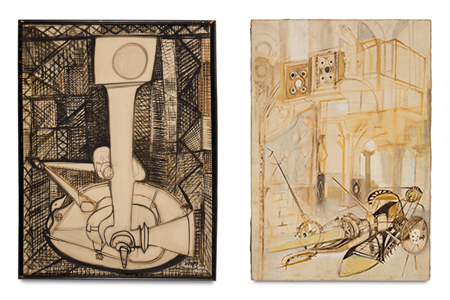An Under-the-Radar Artist Enjoys a Posthumous Revival
by Natasha Wolff | March 4, 2016 12:50 pm
Hedda Sterne might be best known for an iconic 1951 photograph from Life magazine, in which she’s the only female among a group of more famous Abstract Expressionists, billed as the “Irascibles.” The picture shows Sterne, a prolific painter, standing on a chair above Jackson Pollock, Willem de Kooning, Mark Rothko and other art-world heavyweights. But she thought little of the portrait and its lofty implications, loath to be labeled and lumped in with a certain group or style. “In terms of career,” she would say 30 years later, “it’s probably the worst thing that happened to me.”
With that it mind, it seems like Sterne, who died in 2011 at 100 years old, would be pleased with more recent developments, which have seen her stepping away from the pack and into the spotlight on her own.
“She made art for herself,” explains Dorsey Waxter, partner of New York’s Van Doren Waxter gallery and host of a solo exhibition of Sterne’s work this spring. “By not becoming competitive and being involved in the marketplace, it kept her fresh, to allow new ideas to take germination, develop and evolve.”

“Anthropograph #19” (1949); “Untitled” (c. 1950).
The exhibition, Machines 1947–1951, featuring eight paintings and six works on paper, reflects a recently increased level of interest in her work. The show comprises anthropomorphic renderings reminiscent of household appliances, farm equipment, urban phenomena—products of American industry that captured her fascination. “I think her vision of the future was prescient,” says the architect Karen Van Lengen, a longtime friend of Sterne’s. “Because she’s painting those machines as if they’re almost human, and that is where we are today.”
Sterne, born in Bucharest, Romania, in 1910, fled the Nazi invasion for the U.S. in 1941. Though she had built an impressive oeuvre by that point, having shown her work at her friend Peggy Guggenheim’s London gallery[1] and in other major exhibitions in the U.S., it wasn’t until she became a naturalized citizen stateside, in 1946, that her style started to take on a dynamic life of its own. It was also around then that Sterne and fellow Romanian émigré Saul Steinberg, the acclaimed illustrator and her husband of 55 years (the two later separated but remained married until his death in 1999), spent their Sundays driving around the city and nearby countryside, sketching the new bridges and towers of the postwar building boom.
“She found the humanistic, the gentle and the wild sides to these impossible structures and environments—an artist falling in love with a country,” says Shaina Larrivee, director of the Hedda Sterne Foundation, referencing that period in her career. Waxter and her team wanted to introduce the larger public to Sterne’s work with pieces she made during this acclimation to her new country and, more pointedly, New York City[2]. As Larrivee explains, “It’s the beginning of Hedda Sterne as a New Yorker, and that was the largest part of her life.”
- London gallery: http://dujour.com/news/simon-rose-concierge-intercontinental-london-park-lane/
- New York City: http://dujour.com/cities/new-york/
Source URL: https://dujour.com/culture/hedda-sterne-van-doren-waxter-gallery-exhibition/